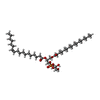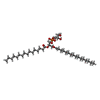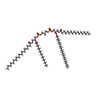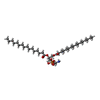+Search query
-Structure paper
| Title | Structural insights into the unusual core photocomplex from a triply extremophilic purple bacterium, Halorhodospira halochloris. |
|---|---|
| Journal, issue, pages | J Integr Plant Biol, Vol. 66, Issue 10, Page 2262-2272, Year 2024 |
| Publish date | Feb 27, 2024 |
 Authors Authors | Chen-Hui Qi / Guang-Lei Wang / Fang-Fang Wang / Jie Wang / Xiang-Ping Wang / Mei-Juan Zou / Fei Ma / Michael T Madigan / Yukihiro Kimura / Zheng-Yu Wang-Otomo / Long-Jiang Yu /    |
| PubMed Abstract | Halorhodospira (Hlr.) halochloris is a triply extremophilic phototrophic purple sulfur bacterium, as it is thermophilic, alkaliphilic, and extremely halophilic. The light-harvesting-reaction center ...Halorhodospira (Hlr.) halochloris is a triply extremophilic phototrophic purple sulfur bacterium, as it is thermophilic, alkaliphilic, and extremely halophilic. The light-harvesting-reaction center (LH1-RC) core complex of this bacterium displays an LH1-Q transition at 1,016 nm, which is the lowest-energy wavelength absorption among all known phototrophs. Here we report the cryo-EM structure of the LH1-RC at 2.42 Å resolution. The LH1 complex forms a tricyclic ring structure composed of 16 αβγ-polypeptides and one αβ-heterodimer around the RC. From the cryo-EM density map, two previously unrecognized integral membrane proteins, referred to as protein G and protein Q, were identified. Both of these proteins are single transmembrane-spanning helices located between the LH1 ring and the RC L-subunit and are absent from the LH1-RC complexes of all other purple bacteria of which the structures have been determined so far. Besides bacteriochlorophyll b molecules (B1020) located on the periplasmic side of the Hlr. halochloris membrane, there are also two arrays of bacteriochlorophyll b molecules (B800 and B820) located on the cytoplasmic side. Only a single copy of a carotenoid (lycopene) was resolved in the Hlr. halochloris LH1-α3β3 and this was positioned within the complex. The potential quinone channel should be the space between the LH1-α3β3 that accommodates the single lycopene but does not contain a γ-polypeptide, B800 and B820. Our results provide a structural explanation for the unusual Q red shift and carotenoid absorption in the Hlr. halochloris spectrum and reveal new insights into photosynthetic mechanisms employed by a species that thrives under the harshest conditions of any phototrophic microorganism known. |
 External links External links |  J Integr Plant Biol / J Integr Plant Biol /  PubMed:38411333 PubMed:38411333 |
| Methods | EM (single particle) |
| Resolution | 2.42 Å |
| Structure data | EMDB-36907, PDB-8k5o: |
| Chemicals |  ChemComp-HEC:  ChemComp-PGV:  ChemComp-LHG: 
PDB-1lzm: Unknown entry  PDB-1lzp:  ChemComp-UQ8: 
ChemComp-UNL:  ChemComp-FE:  ChemComp-MQ8:  ChemComp-CDL:  ChemComp-LYC:  PDB-1lzq:  ChemComp-PEF:  ChemComp-BGL: |
| Source |
|
 Keywords Keywords | PHOTOSYNTHESIS / RC-LH complex / HALORHODOSPIRA HALOCHLORIS |
 Movie
Movie Controller
Controller Structure viewers
Structure viewers About Yorodumi Papers
About Yorodumi Papers





 halorhodospira halochloris (bacteria)
halorhodospira halochloris (bacteria)